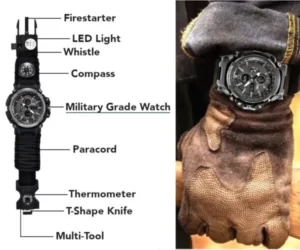Watches are meant to be durable and water-resistant to a certain degree, but not all watches can withstand being submerged in water. It can be difficult to know if your watch is waterproof or not, and if it is, how deep you can go without damaging it.
In this article, we will explore how to tell if your watch is waterproof and what level of water resistance is best for different water activities.
You may be interested in our article about how to remove moisture from your watch.

Understanding the water resistance rating of your watch:
The water resistance rating of a watch indicates its ability to withstand water pressure and potential water ingress. It is typically expressed in meters or ATM (atmospheres). Understanding this rating is crucial to determine the watch’s limitations and ensure its proper use. For example, a 50-meter water resistance rating means the watch can handle splashes and brief immersion but is not suitable for swimming or diving.
Familiarize yourself with the specific water resistance rating of your watch and adhere to the recommended usage guidelines provided by the manufacturer.
Conducting a water resistance test at home:
While professional water resistance tests are recommended, you can perform a basic water resistance test at home. Fill a bowl with water and submerge the watch for a brief period, carefully observing for any signs of water ingress. If there are visible condensation, moisture, or a stopped or malfunctioning movement, it indicates potential water damage.
It is important to note that this test may not provide the same level of accuracy as professional tests, and it is advisable to have your watch professionally tested for water resistance periodically.
Identifying signs of water damage on your watch:
Detecting water damage on a watch is essential to address any potential issues promptly. Signs of water damage may include foggy or misted-up crystals, water droplets inside the watch, discolored dial or hands, or a malfunctioning movement.
If you notice any of these signs, it is crucial to stop using the watch immediately and have it inspected and serviced by a professional watchmaker. Prompt attention can prevent further damage and potentially save the watch from more extensive repairs.
Knowing when to get your watch serviced:
Regular servicing is vital to maintain the water resistance and overall functionality of your watch. The recommended service intervals can vary depending on the manufacturer and the watch model. However, as a general guideline, it is advisable to have your watch serviced every three to five years, or as recommended by the manufacturer.
Regular servicing allows for the inspection, lubrication, and replacement of worn-out gaskets or seals, ensuring the watch’s water resistance remains intact. Additionally, if you experience any water-related incidents or notice signs of water damage, seek professional servicing immediately.
Tips for maintaining the water resistance of your watch:
To maintain the water resistance of your watch, follow these tips:
- Avoid exposing your watch to water beyond its rated depth.
- Keep the crown and pushers properly screwed down or pushed in when not in use.
- Rinse the watch with freshwater after exposure to saltwater or chlorine to remove any residues.
- Avoid operating the crown or pushers while underwater or when the watch is wet.
- Regularly inspect the gaskets and seals for signs of wear or damage and have them replaced during servicing.
- Avoid subjecting the watch to extreme temperature changes, as it can affect the seals.
- If you participate in water activities regularly, consider a watch specifically designed for diving or water sports with higher water resistance ratings.
By following these maintenance tips and adhering to the watch’s water resistance capabilities, you can prolong the lifespan and ensure the water resistance of your watch.
Conclusion
In conclusion, determining whether your watch is waterproof or water-resistant is important in protecting your investment and preventing any water damage. There are several methods to test the watch’s water resistance, including using a water resistance tester or sending it to a professional for testing.
Always follow the manufacturer’s instructions and recommendations for usage and maintenance to ensure that your watch lasts for years to come.

